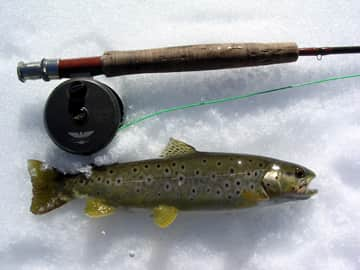Wisconsin Early Inland Catch-and-release Trout Season Opens March 2
OutdoorHub 02.20.13

Getting psyched up for the early catch-and-release trout season in Wisconsin – which runs 5 a.m. March 2 to midnight April 27 this year – is a late winter survival tactic for some anglers.
At the Badger Fly Fishers Spring Opener held earlier this month in Madison, hundreds of fly casters gathered to stock up on materials and gear, spend outrageous sums of money on chicken feathers, learn from a room full of master fly tiers and trade in their most precious commodity – stories of battles won and lost on the fast-flowing, cold-water streams that hold trout, waters so beautiful they sooth the mind and nourish the spirit.
Of course not everyone is itching to be on the water before dawn on March 2, when temperatures could be below freezing.
“I don’t start in the early, early spring,” said Rich Mlodzik of Princeton, an otherwise hardcore fisherman who attended the event. “I get out around the first of April. I’m a 50 degrees kind of guy.”
The early season is for anglers who like to fool their prey with artifice rather than bait. It’s for people who think how they hook a trout is as just as important as actually catching it. These fall into two main groups – spinner fishers and fly fishers. Each style has its advantages. Spinner fishers, for instance, can reach into deeper pools on small, alder-choked streams that defeat fly casters.
While the best early-season fishing generally does occur in mid to late April, there are some golden opportunities in March. Some hardy fishermen will be out on opening day no matter the weather, anxious to hunt trout that haven’t seen an artificial lure for at least five months.
Others will watch for those mid-March days when the sun burns hot, the ice begins a rapid melt and black stone flies can be spotted on the snow bordering streams with rocky substrates. These insects flitter moth-like across the water and trout will actually leap out of the water to catch them. Even larger brown trout that normally don’t approach the surface midday will chase them with seeming abandon. A angler with the right fly can have a blast.
Until the snow melts, the best time to fish is from noon to 4 p.m. when the water temperatures are higher. Then, as the early season progresses, the fishing just gets better and better. Wooly buggers (generally a larger fly) and scuds (a small fly) are good choices for going below the surface when there isn’t activity on top.
“After the snow melts, trout activity increases,” said Heath Benike, a fisheries biologist with the state Department of Natural Resources at Eau Claire. “Some of the biggest trout of the season are caught in mid-April as the fish become more active and aggressive.”
Most trout streams are open to early fishing with the exception of most Lake Superior tributaries and the majority streams in northeast Wisconsin. To find the open streams, check the printed current trout fishing regulations pamphlet for specific waters. Anglers are required to use artificial lures and flies; barbless hooks are not required. The daily bag limit and possession limit for trout during this time is zero – all trout caught must be immediately released.
An inland trout stamp is required in addition to a Wisconsin fishing license.
Biologists and others who study trout populations say that these are the good old days of trout fishing. Trout populations have generally increased statewide, and the number of fish in all sizes examined have increased, since 1950, according to a University of Wisconsin-Stevens Point analysis released in 2011 and discussed in “A Trout Treasury,” an April 2011 Wisconsin Natural Resources magazine article.
Readers can also find an interesting discussion on spinner fishing [PDF] on the fishing Wisconsin pages of the DNR website.
The best fishermen, probably out of some sort of psychological necessity, are optimists. They remember their best days on the water and expect better days ahead. But they are also pragmatists and are careful to plan for all contingencies.
Online maps and interactive maps will make all of the trout waters easier to find and provide other information to increase anglers success. The maps, along with other information to help you find easy public access to trout waters and some new places to fish, are available by searching the on DNR website for inland trout fishing.

